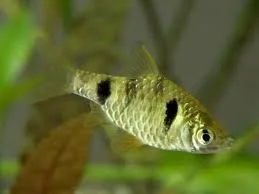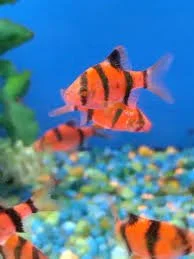 Image 1 of 1
Image 1 of 1


Barb- Indian Dwarf
The Indian dwarf barb, also known as the Golden Dwarf Barb (Pethia gelius), is a small, peaceful, and active freshwater fish native to South Asia, measuring about 1.4–1.6 inches (3.5–4 cm). They are a golden-yellow color with faded black striping, but their coloration can vary by individual and can change with their mood. This schooling fish is ideal for nano aquariums and is more timid than other barb species.
Appearance
Size: Adults average around 1.4–1.6 inches (3.5–4 cm).
Coloration: A base of golden-yellow with faded black striping or spots. Some may have a greenish or coppery sheen, or even a rusty-red color.
Dimorphism: Males are typically slimmer and more brightly colored, while females are rounder and larger.
Behavior and temperament
Social: They are peaceful schooling or shoaling fish that thrive in groups of at least 8–10 individuals.
Active: They are energetic but not frenetic, moving with intention and using all levels of the tank.
Peaceful: They are not boisterous like some other barbs and are well-suited for community tanks with other small, peaceful fish.
Habitat: They appreciate well-planted tanks with hiding spots to reduce their natural shyness.
Other facts
Diet: They are omnivores that accept high-quality flake foods, micro pellets, and frozen foods like bloodworms.
Origin: They are native to parts of India, Bangladesh, and Nepal, living in slow-moving streams and rivers.
Breeding: They are egg-scatterers and can be bred in captivity.
The Indian dwarf barb, also known as the Golden Dwarf Barb (Pethia gelius), is a small, peaceful, and active freshwater fish native to South Asia, measuring about 1.4–1.6 inches (3.5–4 cm). They are a golden-yellow color with faded black striping, but their coloration can vary by individual and can change with their mood. This schooling fish is ideal for nano aquariums and is more timid than other barb species.
Appearance
Size: Adults average around 1.4–1.6 inches (3.5–4 cm).
Coloration: A base of golden-yellow with faded black striping or spots. Some may have a greenish or coppery sheen, or even a rusty-red color.
Dimorphism: Males are typically slimmer and more brightly colored, while females are rounder and larger.
Behavior and temperament
Social: They are peaceful schooling or shoaling fish that thrive in groups of at least 8–10 individuals.
Active: They are energetic but not frenetic, moving with intention and using all levels of the tank.
Peaceful: They are not boisterous like some other barbs and are well-suited for community tanks with other small, peaceful fish.
Habitat: They appreciate well-planted tanks with hiding spots to reduce their natural shyness.
Other facts
Diet: They are omnivores that accept high-quality flake foods, micro pellets, and frozen foods like bloodworms.
Origin: They are native to parts of India, Bangladesh, and Nepal, living in slow-moving streams and rivers.
Breeding: They are egg-scatterers and can be bred in captivity.






